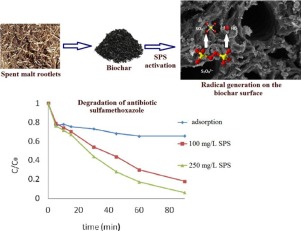Catalysis Today ( IF 5.3 ) Pub Date : 2017-12-28 , DOI: 10.1016/j.cattod.2017.12.028 Liana Kemmou , Zacharias Frontistis , John Vakros , Ioannis D. Manariotis , Dionissios Mantzavinos

|
Spent malt rootlets were valorized to synthesize biochars for water treatment. In particular, the ability of biochar (BC) to activate sodium persulfate (SPS) for the oxidation of sulfamethoxazole (SMX), a representative antibiotic belonging to the family of emerging micro-contaminants, was tested. The biochar was fully characterized by nitrogen adsorption, FTIR spectroscopy, SEM, XRD, TGA and potentiometric mass titration (PMT); the biochar has a specific surface area of 100 m2/g, a point of zero charge value of 8.4 and its surface contains, amongst others, a considerable amount of hydroxyl groups probably in phenolic structure.
The effect of various parameters such as SPS concentration (100–600 mg/L), SMX concentration (125–500 μg/L) and the water matrix (pure water, bottled water, treated domestic wastewater, alcohols as radical scavengers and humic acid) on degradation was investigated. The actual matrix effect on degradation was minor and so was the effect of radical scavengers. Based on the PMT curves, persulfate activation seems to occur on the biochar surface through interactions with the surface functional groups, generating radicals that are not released in the solution; this mechanism is promoted by the presence of humic acid.
The biochar-induced SPS activation was also coupled with either 20 kHz ultrasound irradiation or simulated solar light. In either case, the combined activation was more efficient than the individual ones, leading to process synergy; the degree of synergy, based on pseudo-first order rate constants, was 23–35%.
中文翻译:

生物炭活化过硫酸盐降解抗生素磺胺甲恶唑:影响活化和降解过程的因素
将用过的麦芽小根增值以合成生物炭进行水处理。特别地,测试了生物炭(BC)活化过硫酸钠(SPS)氧化磺胺甲恶唑(SMX)(属于新兴的微污染物家族的代表性抗生素)的能力。生物炭通过氮吸附,FTIR光谱,SEM,XRD,TGA和电位滴定法(PMT)进行了全面表征。生物炭的比表面积为100 m 2 / g,零电荷点为8.4,并且其表面除其他外,可能含有酚结构的大量羟基。
各种参数的影响,例如SPS浓度(100–600 mg / L),SMX浓度(125–500μg/ L)和水基质(纯水,瓶装水,经处理的生活废水,作为自由基清除剂的醇和腐殖酸) )进行了研究。实际的基质对降解的影响很小,自由基清除剂的影响也很小。根据PMT曲线,过硫酸盐活化似乎是通过与表面官能团的相互作用在生物炭表面发生的,从而产生了未在溶液中释放的自由基。腐殖酸的存在促进了这种机制。
生物炭诱导的SPS活化还与20 kHz超声辐射或模拟太阳光结合在一起。在这两种情况下,组合激活都比单个激活更有效,从而导致过程协同。基于伪一级速率常数的协同作用程度为23–35%。



























 京公网安备 11010802027423号
京公网安备 11010802027423号